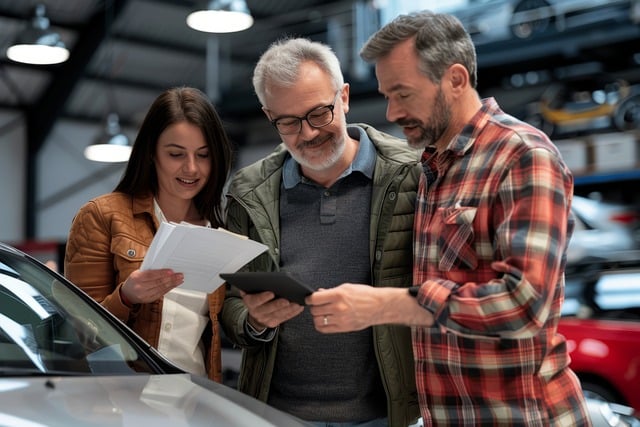Purchasing a used car can be an astute financial decision, providing significant savings compared to buying new. However, it does come with its own challenges and risks. Understanding the ins and outs of buying a second-hand vehicle can help you make an informed choice, ensuring reliability and value for money. Here are seven essential tips to guide you through the process.
Assessing Your Needs
Before jumping into the world of used cars, it’s crucial to clearly define what you need from a vehicle. Are you looking for a practical family car or something sportier for occasional use?
Consider the number of passengers you’ll regularly carry, the type of driving you do most (city vs. motorway), and any additional features you might require, such as ample boot space or advanced safety features. Knowing what you need will help narrow down your options and prevent getting sidetracked by appealing but impractical choices.
Additionally, think about future needs. If you plan to expand your family or start a new job with a long commute, these factors should influence your decision. Make a list of must-haves and nice-to-haves to guide your search.
Research and Identify Suitable Models
Once you’ve established your requirements, it’s time to research models that meet your criteria. Use online resources such as consumer reviews, reliability surveys, and safety ratings to compile a shortlist of potential vehicles. Websites like the AA, RAC, and What Car? offer comprehensive reviews and comparisons that can be invaluable in this stage.
Compare the running costs of different models, including fuel efficiency, insurance premiums, road tax, and maintenance expenses. Take note of any common issues that might affect certain models or makes. A comprehensive understanding of the vehicles you’re interested in will arm you with the knowledge to make a wise choice.
It’s also useful to visit online forums and discussion groups dedicated to the models on your list. Input from current owners can provide practical insights that professional reviews might not cover.
Setting a Budget
Establishing a clear budget is an essential step in purchasing a used car. Consider not only the purchase price but also the ongoing costs of ownership. Factor in maintenance, insurance, fuel, and potential repairs. Be realistic about what you can afford and avoid the temptation to overextend your finances for a car outside your range.
Decide how you’ll fund the purchase. Will you pay in full upfront, or will you require financing? If you need a loan, shop around for the best rates and terms. Banks, credit unions, and dealership finance options can vary significantly, so it’s worth comparing to find the most favourable deal.
Bear in mind that having a clear budget and sticking to it will help you avoid impulsive decisions and focus on finding a vehicle that provides the best value for your money.
Inspecting the Vehicle
When you’ve identified a potential car, a thorough inspection is crucial. Ideally, bring along a mechanically knowledgeable friend or hire a professional mechanic to examine the vehicle. Look for signs of wear and tear, rust, and any potential accident damage. Check the condition of consumable items like tyres, brakes, and the exhaust system.
Verify the operation of all electrical components, including lights, windows, and the infotainment system. Take the car for a test drive, paying attention to how it handles, any unusual sounds, and the performance of the brakes and steering. Test drives can reveal a lot about a car’s condition that isn’t immediately apparent when it’s stationary.
Additionally, inspect the interior for wear, ensuring that all the features (like air conditioning and seat adjustments) work correctly. A well-maintained interior often indicates that the previous owner took good care of the vehicle overall.
Checking Vehicle History
A comprehensive vehicle history report is an invaluable tool when buying a used car. This report can reveal critical information about the car’s past, such as:
- Previous owners
- Accident history
- Title status (e.g., if it’s been written off (write-off check) or stolen)
- Service records
- Mileage verification
Services like Motorscan or the DVLA’s online tools can provide detailed history reports. These checks require the vehicle’s registration number and possibly its VIN (Vehicle Identification Number). Don’t rely solely on the seller’s word; independent verification is essential to avoid surprises.
Pay attention to the service history. A well-documented maintenance record indicates that the car has been regularly serviced and cared for, which can mean a longer lifespan and fewer unexpected repairs.
Negotiating the Price
Once you’ve found a car that meets your needs and passed your inspections, it’s time to negotiate the price. Do some research to understand the fair market value of the car based on its age, condition, mileage, and specifications. You can use resources like Value My Car and Parkers Price Guide as benchmarks.
When negotiating, be polite but firm. Start with a lower offer than the asking price but reasonable enough to engage in a discussion. Be prepared to point out any issues discovered during your inspection and use them as bargaining chips. If the car requires new tyres or has upcoming maintenance, these can be valid reasons for requesting a lower price.
Remember, negotiating isn’t just about price. You can discuss terms such as including a warranty, servicing, or additional accessories in the final deal.
Finalising the Purchase
After agreeing on a price, it’s crucial to ensure all paperwork is in order. Verify that the V5C registration document matches the seller’s details and the car’s VIN. Also, check that there’s no outstanding finance on the vehicle unless clearly stated and agreed upon.
If buying from a dealer, ensure you receive a valid invoice detailing the car’s make, model, registration, price, and any agreed terms. For private sales, a bill of sale signed by both parties should be sufficient.
Arrange payment securely, avoiding large cash transactions. Bank transfers or banker’s drafts provide a clear and traceable method of payment. Upon completion, ensure you receive all sets of keys and any relevant documents, such as the service book, manuals, and MOT certificates.
Driving away in your newly purchased used car brings a sense of accomplishment and satisfaction, knowing you’ve made a well-informed decision.
Summary of Buying a Used Car
In conclusion, buying a used car requires careful consideration and diligent research. By clearly understanding your needs, extensively researching suitable models, setting a realistic budget, thoroughly inspecting the vehicle, checking its history, negotiating effectively, and ensuring proper documentation, you can navigate the used car market with confidence. Each step plays a critical role in securing a reliable and valuable vehicle. Happy motoring!
Help keep news FREE for our readers
Supporting your local community newspaper/online news outlet is crucial now more than ever. If you believe in independent journalism, then consider making a valuable contribution by making a one-time or monthly donation. We operate in rural areas where providing unbiased news can be challenging. Read More About Supporting The West Wales Chronicle

























